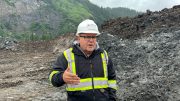In the global competition for investment in the new, low-carbon economy, Ontario stands out as an existing centre of both mining and auto manufacturing, a conference in Washington, D.C. heard in April.
“We’re really uniquely positioned to have a lead role in the energy transition,” Canada Nickel (TSXV: CNC) CEO Mark Selby, said.
“Because of a long history of mining, we have well-established infrastructure. We have rail lines that go from our mines to the automobile factories.”
Selby was part of an Ontario-sponsored panel that included project developers, a mining researcher, and Ontario Mines Minister George Pirie at the Energy Transition Metals Summit on April 29. Organized by The Northern Miner and Precious Metals Summit Conferences, the event took place April 29-30.
Pirie said there’s an “easy” answer to questions about Ontario’s advantages in the energy transition.
“We have the minerals, we have the energy, we have the green grid,” he said. “We have generations of people that are involved with the mining sector. We know how to mine sustainably, we know how to minimize the carbon footprint.”
Billion-dollar investments
Less than two weeks before the event, Honda Motor announced a $15-billion investment to build four new battery and vehicle plants in southern Ontario. The investment came alongside $2.5 billion from the federal government and up to $2.5 billion in incentives from the provincial government.
“I think that that brings the total investment in the EV sector to over $43 billion. And that’s because this is what Ontario has to offer,” Pirie said.
David Ewing, vice-president of sustainability with Frontier Lithium (TSXV: FL; US-OTC: LITOF), said the wider policy and regulatory environment puts the province in a strong place for developing critical minerals. The Ontario government was out of the gate early, Ewing said, mainly through the development of its Critical Minerals Strategy in March 2022 and also through investments and collaboration with industry.
“We’re building on a fantastic foundation in Ontario, whether that be with skilled workforces, whether it be with knowledgeable governments, we have a strategy that’s backing it, we have funding,” he said. “It really does enable us to take mine projects from exploration through to production more rapidly than we’ve seen in the past.”
Frontier is developing the prefeasibility-stage PAK project in northwestern Ontario. In March, Japanese automaker Mitsubishi invested $25 million for a 7.5% stake in a Frontier subsidiary, with an option to increase to 25% after a definitive feasibility study for PAK expected this year.
In addition, the province has targeted faster permitting for new mines through its Building More Mines Act passed last year.
Free geophysical data from the Ontario Geological Society has also made discovering new critical minerals deposits easier and less expensive.
“We basically (discovered) potentially 20 deposits, which could be the world’s largest nickel sulphide district, using just the provincially available geophysics data,” Selby said. His company is developing the Crawford nickel project near Timmins, which hosts the world’s second-largest nickel resource, according to a Wood Mackenzie analysis.
Funding woes
But critical mineral projects in Ontario still face obstacles, and Selby and Ewing highlighted the mismatch between capital markets and government support for critical minerals.
Selby noted that provincial and federal funding available in Ontario means companies like his can get 30¢ to 40¢ of every dollar needed for their projects.
“The disconnect right now in the capital markets is so profound,” he said. “(If an industry) said, ‘You can take $1 of your equity and you’re going to have multiple levels of government give you four or five additional dollars of equity to leverage your one and then build assets that last for 30, 40, 60 years.’ It seems like a no-brainer investment. The market just hasn’t woken up to it.”
Green innovation
The industrial and economic magnitude of the energy transition calls for speed and innovation because the technologies of yesterday aren’t suited to the demands of a zero emissions future.
Moderator and The Northern Miner editor-in-chief Alisha Hiyate, asked Nadia Mykytczuk, interim president and CEO of Mining Innovation, Rehabilitation and Applied Research Corp. (MIRARCO) about the role of innovation in developing critical mineral supply chains.
Mykytczuk responded that the pace of research into new technologies needs to move faster than it has in the past. That requires government support. Her non-profit organization is a research arm of Laurentian University in Sudbury.
“We really have to make a concerted effort to fund and accelerate the movement of new technologies,” she said. “We have to think zero waste solutions that have much lower carbon footprint in being able to meet the energy demands of the future, but not by compromising the environment and leaving a very long legacy of mine waste.”
MIRARCO has partnered with such companies as Vale (NYSE: VALE) and BacTech Environmental on research into bioleaching technologies that recover critical minerals from tailings, which remain an issue in the Sudbury area. Mykytczuk estimates there’s $8 to $10 billion worth of nickel, cobalt and copper in those decades-old tailings.
“We’re looking at a zero waste solution using a low carbon, low energy biotechnology,” she said. “And we’ve got industry partners, government, academia all working together to accelerate these solutions.”






Be the first to comment on "JV Content: Ontario comes out ahead in mines to EV race"